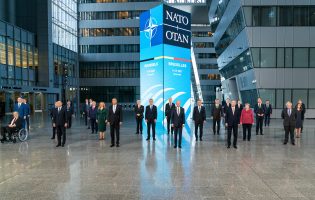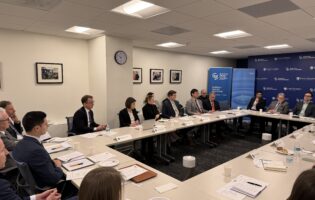Reconciliation in Europe and in East Asia
On September 13, 2016, Harry & Helen Gray/AGI Reconciliation Fellows Nina Janz and Ivo Plšek presented their research in a seminar entitled “Reconciliation in Europe and in East Asia: How Countries Face a Past of War.” Nina Janz discussed “Reconciliation over the Graves? A German War Cemetery in Russia,” and Ivo Plšek presented “Reconciliation Politics of the Postwar Left in Japan and Germany: A Comparison of Approaches to Reparations Agreements with Southeast Asia.”
Reconciliation over the Graves? A German War Cemetery in Russia
Germany lost millions of soldiers in Russia during World War II, but it was not until 1992, fifty-five years after the end of the war, that an agreement was signed between Russia and Germany about German war graves on Russian soil. Only after this agreement was signed could Germany try to find 1 million lost soldiers whose bodies were never recovered from the front. While this agreement was a major step in reconciliation between the two countries, it did not come without some controversy. Would it be possible for Germany to mourn its fallen while Russia celebrates its victories?
In Sologubovka, Russia, two narratives clashed when the German War Graves Commission (Volksbund Deutsche Kriegsgräberfürsorge e.V.) wanted to establish a cemetery for German soldiers on a battlefield site. Russians wanted to honor and celebrate their military heroes and Germans wanted to mourn the loss of soldiers. Russia viewed these fallen soldiers as fascists and Nazis and did not want these people memorialized as victims.
One way the War Graves Commission sought to mitigate the narrative clash was through the church at Sologubovka. During the war, the church was used as a hospital and was the site of 3,000 German graves. Working with the local Orthodox Church community, the Commission was able to rebuild the church and transform it to a central component of the German war graves memorial. The connection to the church was an extremely important step in reconciliation. It connected the graves to Christian values and to the belief that all dead should be buried and united Germans and Russians under one roof.
The church became extremely important in another narrative clash in the war cemetery. The Commission wanted to place a sculpture at the center of the cemetery, the Mourning Mother of Nagasaki. In Germany, this sculpture evoked a way for parents to mourn the losses of their children who were killed in the war. Russians, however, saw this as an attempt to turn soldiers into innocent victims, putting them in the same category as the civilian victims who died in German sieges. “Nagasaki” also evoked the victims of American nuclear attacks on the Japanese city. As a compromise, the Commission placed the Mourning Mother of Nagasaki to the side of the cemetery and placed the Christian symbol of the cross in the center.
From the beginning of the project, the German War Graves Commission sought to develop the war cemetery, Peace Park, and Church of Reconciliation as an aspect of reconciliation. Even with the formal agreement between the countries signed in 1992, the attitudes and relations between Germany and Russia made understanding, dialogue, cooperation, and forgiveness between these two countries extremely difficult. In Russia, the agreement had to be implemented in a top-down way, as local authorities and communities, many of them descendants of victims of German aggression, were extremely resistant to the efforts. While the Germans have access to the graves of their soldiers and the memorial has been built, forgiveness has not necessarily occurred.
Reconciliation is a process, and these sites are still very problematic to Russians. The graves are situated near sites that were devastating to the Russian population, and they view Germans as aggressors. They allow the Commission to bury them but without honoring or memorializing them. However, the church has been a major source of mediation, as have the graves themselves. Russian and German soldiers work together to exhume bodies and bury them properly in the sites. Russian cemeteries and memorials are nearby; there are possibilities for future collaboration. And as many German soldiers’ remains are still not located, this project provides further possibilities for reconciliation between Germany and Russia.
Reconciliation Politics of the Postwar Left in Japan and Germany: A Comparison of Approaches to Reparations Agreements with Southeast Asia
The Japan Socialist Party (JSP) is the rival party to the Liberal Democratic Party (LDP), which has continuously been in power since its foundation in 1955, with the exception of a period between 1993 and 1994 and again from 2009 to 2012. Comparing the JSP to the Social Democratic Party (SPD) of Germany in the post-World War II era, Dr. Ivo Plšek’s research project examined whether reconciliation would have been a success in East Asia if the JSP instead of the LDP had been in power for most of the postwar period.
The JSP’s international relations and views toward reconciliation are somewhat opposed. The JSP favors closer ties to Asia, while the LDP has always been closer to the West, in particular the United States. However, surprising rhetoric regarding reparations agreements in the 1950s with various countries, including Burma and the Philippines, pointed in the opposite direction. The JSP was not in favor of these reparation treaties. It was much later in the postwar period that the JSP did recognize Japan’s war crime and guilt, but not initially.
In contrast, Germany’s SPD was instrumental for the Luxembourg Treaty, which dealt with West Germany’s reparations to Israel. The SPD members supported the treaty from its conception to ratification and ensured its passage. Despite public opinion against it, the SPD voted unanimously within the parliament to ratify the treaty.
These differences between the SPD and JSP’s reaction to ratification of reparations treaties could be explained by their wartime experiences and the development of the parties after the war. The SPD leadership had very particular and personal experiences with war and war victims. Many were subjected to Gestapo scrutiny and imprisonment and were part of the resistance. When they returned to government after 1945, their war experience informed their policies.
The JSP leadership, on the other hand, had limited war experience. Those who resumed party activities after 1945 were close to the imperialist party and nationalistic movement in Japan. None experienced a concentration camp; none have military experience. They were far removed from the war experience in Asia and from the experiences of victims. To add to this, the JSP experienced organizational continuities after the war; the party politics continued as it did before World War II. Their politics remained stolidly Marxist, and ideologies did not take on a moral component in the immediate postwar period.
As a result, it is doubtful that the JSP, had it been in power at the time, would have changed the reconciliation effort, at least not unilaterally for all Asian countries affected. The contemporary JSP party, however, positions itself against whitewashing history and supports the victim narrative.
Contact Ms. Elizabeth Caruth, Program Coordinator, at ecaruth@aicgs.org with any questions.
Location
AICGS R. G. Livingston Conference Room
1755 Massachusetts Avenue NW Suite 700 Washington, DC 20036 United States







